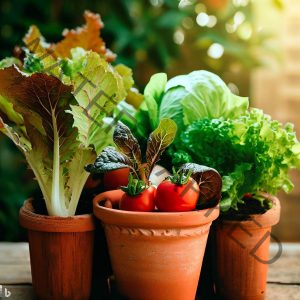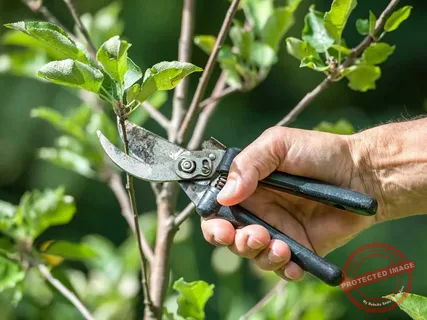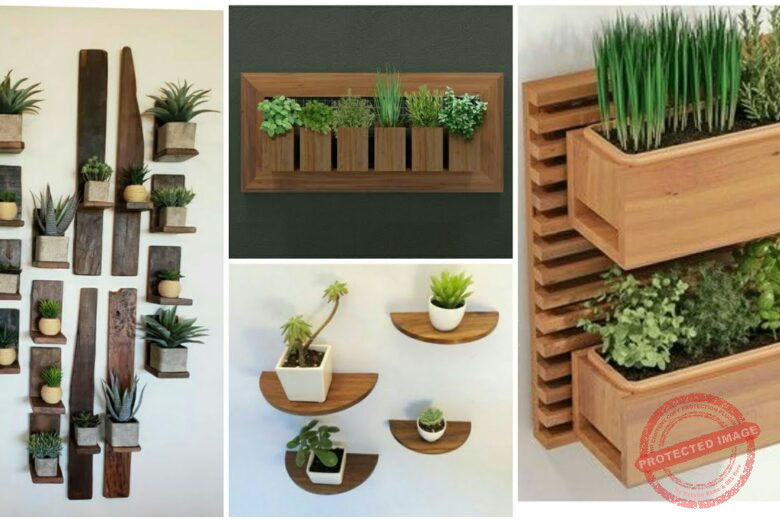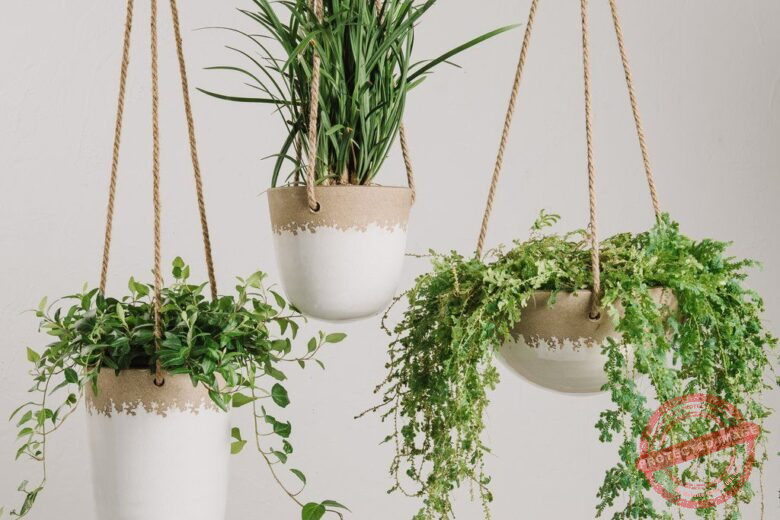Gardening is a delightful and rewarding hobby that allows you to cultivate your own fresh produce right at home. Even if you lack a sprawling garden, you can still enjoy the benefits of homegrown vegetables by growing them in pots.
The easiest vegetables to grow in pots are those with compact growth habits and adaptable to container gardening. Herbs like basil, mint, and parsley are beginner-friendly choices, requiring minimal space and care. Additionally, lettuce varieties and radishes are quick-growing vegetables that thrive in containers, making them ideal for those new to gardening in limited spaces.
Container gardening offers a convenient way to nurture plants, even if you have limited space. In this article, we’ll explore 25 easy vegetables that you can successfully grow in pots, making your gardening journey both fruitful and satisfying.
25 Easiest Vegetables to Grow in Pots: A Beginner’s Guide
Whether you’re a seasoned gardener or just starting out, growing vegetables in pots offers a versatile way to enjoy fresh produce without the need for a large garden plot. Container gardening allows you to take advantage of available space, whether it’s a sunny balcony, a small patio, or even a windowsill. Let’s delve into the world of container gardening and discover the array of vegetables you can easily cultivate in pots.
Now, let’s explore the exciting world of vegetables that thrive in containers. These 25 easy-to-grow options offer delicious rewards and are well-suited for beginners:

1. Tomatoes
Tomatoes are a popular choice for container gardening due to their versatility and vibrant flavors. Opt for compact or dwarf varieties, and provide sturdy support for their vines.
Read Also: [Beginner’s Guide] How To Grow Avocado In Kenya
2. Lettuce
Lettuce is a fast-growing leafy green that adapts well to pots. You can even grow different varieties in the same container for a colorful salad mix.
3. Radishes
Radishes are a quick and rewarding crop, perfect for beginners. They take up minimal space and add a spicy crunch to salads.
Read Also: 50 Best Beginner Plants For Gardening [Easy To Grow]
4. Spinach
Spinach thrives in cooler weather and can be harvested multiple times. Choose a deep pot to accommodate its root system.
5. Green Onions
Green onions are incredibly low-maintenance and can be grown from scraps. Snip off what you need while they continue to grow.
6. Carrots
Carrots can be grown in deeper pots to accommodate their taproots. Choose shorter varieties for easier container growth.
Read Also: Avocado Seed Growing Stages [A Comprehensive Guide]
7. Bell Peppers
Bell peppers thrive in larger containers and bring vibrant colors to your garden. They require plenty of sunlight and warmth.
8. Herbs (Basil, Mint, and Parsley)
Herbs are excellent choices for container gardening. Basil, mint, and parsley can be grown together, providing fresh flavors for your dishes.
Read Also: 25 Easiest Vegetables To Grow Indoors
9. Cucumbers
Choose bush cucumber varieties for container gardening. Provide support for their vines and enjoy crisp cucumbers all summer.
10. Bush Beans
Bush beans are compact and don’t require trellises. They’re prolific producers, offering a steady supply of beans.
11. Zucchini
Dwarf zucchini varieties are suitable for containers. Regular harvesting encourages continued production.
Read Also: 25 Fastest Growing Vegetables in Summer
12. Cherry Tomatoes
Cherry tomatoes are smaller and well-suited for pots. They’re perfect for snacking and adding to salads.
13. Peas
Peas can be grown in both spring and fall. Use trellises to support their climbing habit.
14. Beets
Beets have edible greens and roots. They thrive in deep pots and offer a double harvest.
Read Also: [Complete Guide] 50 Gardening Tips For Beginners
15. Kale
Kale is hardy and can tolerate cooler temperatures. It’s packed with nutrients and adds texture to dishes.
16. Eggplants
Choose compact eggplant varieties for containers. They require warmth and sunlight for optimal growth.
Read Also: How Fast Do Cucumbers Grow? 10 Tips to Accelerate Growth
17. Chard
Chard comes in vibrant colors and is easy to grow in pots. Harvest outer leaves to encourage new growth.
18. Scallions
Scallions, or green onions, can be grown from sets or seeds. They’re perfect for adding a mild onion flavor to dishes.
19. Microgreens
Microgreens are young, tender plants harvested at an early stage. They’re nutrient-dense and add a burst of flavor to salads.
20. Garlic
Garlic can be grown in pots, but it requires a longer growing season. Plant individual cloves and watch them develop.
Read Also: How Fast Do Strawberries Grow? 10 Tips to Boost Growth
21. Cabbage
Cabbage can be grown in larger pots and adds a hearty component to your container garden.
22. Summer Squash
Dwarf summer squash varieties are suitable for containers. Regular harvesting promotes continuous fruiting.
23. Cilantro
Cilantro grows quickly and adds a fresh flavor to dishes. Plant new seeds every few weeks for a continuous supply.
Read Also: How Long Does a Peach Tree Take to Grow: 10 Tips to Grow Faster
24. Cauliflower
Cauliflower requires ample space for its head to form. Choose a larger container and provide consistent moisture.
25. Bush Peas
Bush peas are compact and don’t require trellises. They’re excellent for small spaces and container gardening.
Benefits of Growing Vegetables in Pots
Container gardening presents several advantages, especially for beginners. First and foremost, it’s space-efficient. You can create a mini garden on your porch, deck, or any sunny corner of your home. This is particularly advantageous if you live in an urban setting or have limited outdoor space.
Additionally, growing vegetables in pots gives you greater control over soil quality and composition. You can tailor the potting mix to suit the specific needs of each plant, ensuring optimal growth and development. Furthermore, pots offer better drainage, preventing issues associated with waterlogged roots.
Read Also: 50 Fastest Growing Vegetables and Fruits [2-9 Weeks]
Choosing the Right Containers
Selecting the right containers is crucial for successful container gardening. Opt for pots that are spacious enough to accommodate the mature size of the vegetables you intend to grow. Most vegetables require a depth of at least 8 to 12 inches, but deeper pots are better for larger plants like tomatoes.
When choosing containers, consider materials like terracotta, plastic, or fabric. Each has its pros and cons in terms of aesthetics, weight, and moisture retention. Ensure that your chosen containers have drainage holes to prevent waterlogging.
Selecting the Perfect Potting Mix
The type of potting mix you use significantly impacts your plants’ growth. Avoid using garden soil as it can be heavy and prone to compaction. Instead, opt for a high-quality potting mix that provides good drainage and aeration.
You can purchase pre-made potting mixes, but you can also create your own by combining components like peat moss, vermiculite, perlite, and compost. This mixture provides a balanced blend of nutrients and prevents soil compaction.
Picking the Ideal Location
The success of your container garden hinges on choosing the right location. Most vegetables require at least 6 hours of direct sunlight daily, so pick a spot that receives ample sunlight. If you’re growing indoors, place your containers near a south-facing window or invest in artificial grow lights.
Consider microclimates within your outdoor space. Some areas might be warmer or more sheltered than others, affecting plant growth. Be mindful of wind exposure, as strong winds can dry out pots quickly.
Watering Techniques
Proper watering is essential for the health of your potted vegetables. Containers can dry out more quickly than garden beds, so check the moisture level of the soil regularly. Stick your finger about an inch into the soil; if it feels dry, it’s time to water.
When watering, ensure that the water reaches the root zone. Water until you see excess water draining from the bottom of the pot. However, avoid overwatering, as this can lead to root rot.
Essential Nutrients and Fertilization
Container-grown vegetables rely on you for nutrients, so regular fertilization is key. Use a balanced, water-soluble fertilizer that provides essential nutrients like nitrogen, phosphorus, and potassium. Follow the manufacturer’s instructions for application rates.
It’s a good practice to fertilize your vegetables every 2-4 weeks during the growing season. However, be cautious not to over-fertilize, as this can result in excessive foliage growth at the expense of fruit production.
Planting and Caring for Your Vegetables
Before planting, ensure that your chosen pots have proper drainage holes. Fill the pots with the chosen potting mix, leaving a couple of inches of space below the rim. Plant your chosen vegetables according to their specific spacing and depth requirements.
Water the plants thoroughly after planting, and monitor their moisture levels regularly. Stick to a regular watering schedule, adjusting as needed based on weather conditions. As your plants grow, consider providing stakes or trellises for support, especially for climbing varieties.
Common Problems and Solutions
Container gardening comes with its own set of challenges, but most issues have straightforward solutions. Keep an eye out for pests like aphids or caterpillars and address them promptly with organic pest control methods. Additionally, watch for signs of nutrient deficiency and adjust your fertilization routine accordingly.
Overwatering can lead to root rot, while underwatering can stress the plants. Finding the right balance is crucial for healthy growth. Be vigilant about proper drainage and moisture levels.
Harvesting Your Homegrown Produce
One of the most rewarding aspects of container gardening is the harvest. As your vegetables mature, they’ll be ready for picking. Harvesting times vary based on the type of vegetable. Gently remove the produce from the plant to avoid damaging it.
Freshly harvested vegetables are at their peak flavor and nutritional value. Incorporate them into your meals and enjoy the taste of your labor.
How to Prepare Soil for Planting Vegetables in Pots
The foundation of a thriving container garden is good soil. When preparing soil for planting vegetables in pots, consider these steps:
Choose the Right Potting Mix: Opt for a high-quality potting mix that provides excellent drainage, aeration, and moisture retention. Avoid using garden soil, as it can be too dense and lead to poor root growth.
Enhance Drainage: Place a layer of small rocks or broken pottery shards at the bottom of the pot to facilitate drainage. This prevents water from pooling at the roots, which can cause root rot.
Add Organic Matter: Mix compost or well-rotted manure into the potting mix to enrich it with nutrients. Organic matter improves soil structure and provides essential elements for plant growth.
Consider Nutrient Content: Depending on the vegetables you plan to grow, you might need to adjust the soil’s nutrient content. Incorporate slow-release fertilizers or use liquid fertilizers throughout the growing season.
Maintain pH Balance: Test the pH of the soil and adjust it as needed to suit the preferences of your chosen vegetables. Most vegetables thrive in a slightly acidic to neutral pH range.
Use Lightweight Containers: Opt for lightweight containers made of materials like plastic or fabric. These containers are easier to move and reduce the overall weight of your garden.
Growing Vegetables in Pots on Balcony
Even if you lack a traditional garden, a balcony can serve as a fantastic space for growing vegetables in pots. Here’s how to make the most of your balcony garden:
Assess Sunlight: Determine how much sunlight your balcony receives throughout the day. Most vegetables require at least 6 hours of direct sunlight, so choose vegetables that match your balcony’s light conditions.
Choose Compact Varieties: Opt for compact or dwarf varieties of vegetables to maximize your space. Look for options specifically bred for container gardening.
Utilize Vertical Space: Make use of vertical space by hanging pots or installing trellises. Vining vegetables like tomatoes, cucumbers, and beans can be trained to grow upwards.
Consider Wind Exposure: Balconies can be windy, which can dry out pots quickly. Use windbreaks like screens or plant larger, more stable containers to minimize the impact of strong winds.
Select the Right Containers: Choose containers that fit comfortably on your balcony without overcrowding the space. Consider railing planters, window boxes, and hanging baskets.
Water Carefully: Balcony gardens may dry out faster than traditional gardens due to increased exposure to sunlight and wind. Water your plants regularly and monitor their moisture levels.
Fast Growing Vegetables in Pots
For beginners seeking quick results and a satisfying gardening experience, fast-growing vegetables are a great choice. Some fast-growing options include:
Radishes:
Radishes are among the quickest vegetables to grow. They’re ready for harvest in as little as 20-30 days.
Green Onions:
Green onions can be harvested in around 3-4 weeks after planting. Plus, you can regrow them from scraps.
Lettuce:
Leafy greens like lettuce can be harvested as early as 4-6 weeks after planting, depending on the variety.
Spinach:
Spinach leaves can be harvested within 4-6 weeks. Harvest outer leaves, allowing the center to continue growing.
Microgreens:
Microgreens are incredibly fast-growing and can be ready for harvest within 1-3 weeks, depending on the variety.
Best Vegetables to Grow in Pots
Certain vegetables thrive in the confined space of containers. Here are some of the best vegetables to grow in pots:
Tomatoes: Compact or dwarf tomato varieties are excellent for containers. Provide support for the vines as they grow.
Peppers: Bell peppers and chili peppers are well-suited for pots. They require sunlight and warmth for optimal growth.
Herbs: Basil, mint, parsley, and other herbs are perfect for small containers. They add flavor to your dishes and require minimal care.
Carrots: Choose shorter carrot varieties for containers. Deeper pots allow their taproots to develop properly.
Beans: Bush bean varieties are compact and don’t require trellises. They produce an abundant crop of beans.
Vegetable Container Gardening Ideas
Container gardening allows for creativity and flexibility in designing your garden. Consider these ideas:
Vertical Gardens: Grow vining vegetables on trellises or stakes to save space and create a stunning vertical display.
Colorful Containers: Choose containers in various colors and sizes to add visual interest to your garden.
Companion Planting: Plant compatible vegetables and herbs together in the same container. For instance, tomatoes and basil make great companions.
Tiered Planters: Use tiered planters to create multi-level gardens, maximizing the use of your vertical space.
Windowsill Gardens: Line your windowsills with small containers of herbs or compact vegetables for a charming indoor garden.
Garden Vegetables List
When planning your container garden, consider a variety of vegetables to create a diverse and bountiful harvest. Some garden vegetables suitable for pots include:
- Tomatoes
- Peppers
- Lettuce
- Spinach
- Radishes
- Carrots
- Beans
- Cucumbers
- Zucchini
- Herbs (Basil, Mint, Parsley)
- Green Onions
- Beets
- Kale
- Chard
- Eggplants
Growing Vegetables in Pots for Beginners
If you’re new to gardening, growing vegetables in pots is an excellent starting point. Here’s a step-by-step guide for beginners:
Choose Suitable Vegetables: Select easy-to-grow vegetables that are suitable for container gardening, such as tomatoes, lettuce, and herbs.
Select Containers: Choose containers with drainage holes and sufficient space for root growth. Start with smaller containers and gradually expand as you gain experience.
Prepare Potting Mix: Use a high-quality potting mix with good drainage and aeration. You can add compost or slow-release fertilizers to enrich the soil.
Plant Your Seeds or Seedlings: Follow the planting instructions on the seed packets or plant the seedlings at the appropriate depth.
Water Carefully: Keep the soil consistently moist, but avoid overwatering. Water when the top inch of soil feels dry.
Provide Sunlight: Place your containers in a location that receives at least 6 hours of direct sunlight daily.
Fertilize as Needed: Depending on the vegetable’s requirements, fertilize your plants with a balanced, water-soluble fertilizer.
Monitor and Maintain: Regularly inspect your plants for pests, diseases, and nutrient deficiencies. Prune and harvest as needed.
Enjoy Your Harvest: As your vegetables grow, enjoy the process of watching them thrive and the reward of harvesting your own homegrown produce.
Growing vegetables in pots is a rewarding journey that allows you to experience the joy of gardening, even with limited space. With careful planning, proper care, and a bit of patience, you can cultivate a flourishing container garden and enjoy the taste of your efforts. Happy gardening!
Conclusion
Container vegetable gardening is an accessible and enjoyable way for beginners to explore the world of gardening. From preparing the soil to selecting the best vegetables for your space, each step contributes to a successful and fulfilling gardening experience. Whether you’re growing on a balcony, a windowsill, or a small patio, container gardening offers endless possibilities for cultivating fresh and flavorful homegrown produce. So, roll up your sleeves, get your hands in the soil, and embark on your journey to becoming a container gardening enthusiast!
Can I grow vegetables in pots indoors?
Yes, many vegetables can be successfully grown indoors in pots. Ensure they receive adequate light and ventilation for optimal growth.
How often should I water my potted vegetables?
Water your potted vegetables when the top inch of soil feels dry to the touch. The frequency will depend on factors like temperature, humidity, and the size of the container.
Can I use recycled containers for gardening?
Yes, you can repurpose containers like buckets, old pots, or even wooden crates for gardening. Just ensure they have proper drainage holes and are thoroughly cleaned before use.
Are there vegetables that are challenging to grow in pots?
While many vegetables can thrive in pots, some larger or deeply rooted vegetables like pumpkins and corn might be more challenging due to their space requirements.
Can I reuse potting mix from the previous season?
Yes, you can reuse potting mix from the previous season, but it’s a good practice to refresh it by adding new compost or potting mix to replenish nutrients and improve soil structure.
Can I grow these vegetables indoors?
Absolutely! Many of the listed vegetables can be grown indoors, as long as they receive sufficient sunlight or artificial light. Just ensure proper ventilation and care for your indoor garden.
What are some common mistakes to avoid in container gardening?
Avoid using containers without drainage holes, using poor-quality potting mix, overwatering or underwatering, and planting incompatible vegetables together. Also, be mindful of not overcrowding your pots.
How often should I fertilize my potted vegetables?
Fertilize your potted vegetables every 2-4 weeks during the growing season. Follow the instructions on your chosen fertilizer for accurate application rates.
Do I need to worry about pests in container gardening?
Yes, pests can still affect container gardens. Regularly inspect your plants for signs of pests and take appropriate measures, such as using natural pest repellents or physically removing the pests.
Can I reuse potting mix from the previous season?
Yes, you can reuse potting mix, but it’s important to refresh it. Remove any plant debris and add some fresh compost or new potting mix to replenish nutrients and improve soil structure. This ensures your plants have the best conditions for growth.
Conclusion
Container gardening opens up a world of possibilities for growing your own vegetables, even if you have limited space. With the right containers, potting mix, and care, you can nurture a thriving garden right at your doorstep. Experiment with different vegetables and techniques, and don’t be afraid to learn from your experiences. The satisfaction of seeing your plants flourish and harvesting your homegrown produce is truly unparalleled.




One Reply to “25 Easiest Vegetables to Grow in Pots”